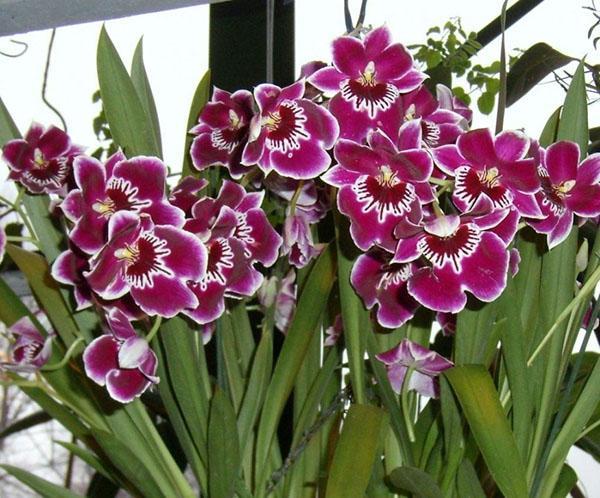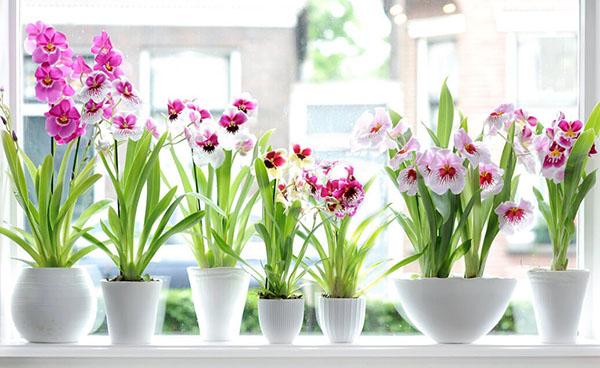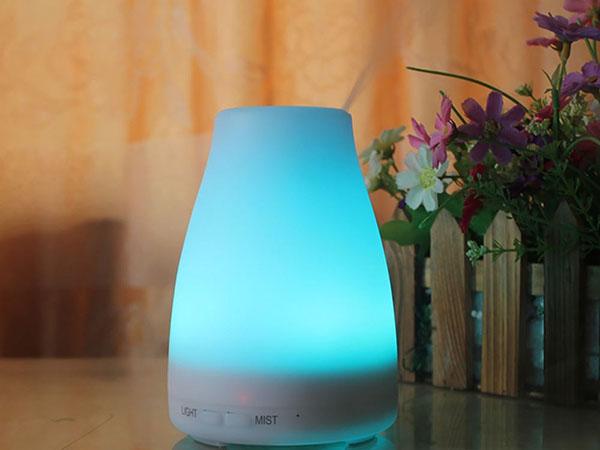Miltonia orchid - a bright decoration of the windowsill
 Among the many species, the miltonia orchid occupies a special place. She is able to decorate with her unusual flowers a collection of not only experienced gardeners, but also a modest home set of plants.
Among the many species, the miltonia orchid occupies a special place. She is able to decorate with her unusual flowers a collection of not only experienced gardeners, but also a modest home set of plants.
Miltonia care at home

Lighting
The flower loves a lot of light, but so that it is diffused. The orchid is also able to grow in partial shade. In this case, the leaves will have a classic green color. To achieve a reddish hue on their surface, it is necessary to provide the plant with a lot of light. In the hot period of the day, it is recommended to shade the flowerpot with a flower, otherwise direct sunlight can leave burns in the form of spots.
In winter, many flower growers put near the flowerpot additional lighting... It can be either a special phytolamp or an ordinary tabletop one.
Air temperature
In the summer, the orchid should be grown indoors, where the thermometer readings are within +200 C. In winter, the flowerpot should be moved to a cooler room. The optimum temperature from October to March is +180 C, not higher.
As for the air temperature day and night, the fluctuations should be within 4 units. The room where the flower is located should be systematically ventilated. During this procedure, the container with the plant must be moved to a place without drafts.
Sudden changes in temperature can adversely affect the development and flowering of miltonia.
Indoor humidity
 The orchid grows best at 70% humidity. Indicators that are below this figure can negatively affect the development of the flower. Miltonia begins to stop growing, the peduncles turn yellow and dry out.
The orchid grows best at 70% humidity. Indicators that are below this figure can negatively affect the development of the flower. Miltonia begins to stop growing, the peduncles turn yellow and dry out.
You can achieve the desired performance with an electric humidifier. It is also recommended to put a container with water near the flowerpot, on the bottom of which to pour expanded clay or pebbles.
Irrigation of miltonia
From early spring to late summer, the plant should be watered abundantly. It is during this period that the intensive growth of the flower falls. During irrigation, remember that the water that has collected at the bottom of the container can cause root rot. Therefore, after each procedure, it is recommended to pour out the liquid.
Watering miltonia at home should be done using the "warm shower" method. Irrigation water should be about 450.
After the soil mixture is well wet, the container must be left for a few minutes to allow excess liquid to glass. Then carefully wipe all the leaves with a soft cloth.
Miltonia: fertilization, rest time, transplant
 In order for the green mass to have a rich color, the orchid should be fertilized once every 14 days. Use the mixture according to the instructions. Violation of the ratio of water and drug can lead to discoloration, as well as deformation of the leaves.
In order for the green mass to have a rich color, the orchid should be fertilized once every 14 days. Use the mixture according to the instructions. Violation of the ratio of water and drug can lead to discoloration, as well as deformation of the leaves.
If Miltonia has abundant and bright flowering, then this means that the culture was properly fertilized.
Dormant period
At the time when pseudobulbs begin to ripen, miltonia must be rearranged to a cooler place. The room temperature should be about +150 C. During rest periods, which is about 16 weeks per year, it is necessary to reduce the number of waterings.
Return to normal care should be after new peduncles begin to appear.
Plant transplant
 It is necessary to change the soil and flowerpot for miltonia 1 or 2 times a year. It all depends on the state of the flower. The procedure should be started immediately if the soil mixture is covered with mold or has an unpleasant odor. Also, a sign that Miltonia needs a transplant is a large number of aerial roots.
It is necessary to change the soil and flowerpot for miltonia 1 or 2 times a year. It all depends on the state of the flower. The procedure should be started immediately if the soil mixture is covered with mold or has an unpleasant odor. Also, a sign that Miltonia needs a transplant is a large number of aerial roots.
A transplant is carried out immediately after the orchid begins to bloom.
Transplant stages:
- Remove the plant from the pot.
- Thoroughly clean all roots from the substrate.
- Remove damaged roots with a sharp knife or secateurs.
- Thoroughly sprinkle the cut sites with crushed activated carbon.
- Pour a drainage layer into a deep container. It should be in the form of a mound.
- Place an orchid in the center of the vessel.
- Fill the rest of the space substrate.
The first watering is carried out 2-3 days after transplanting. Until this time, it is recommended to spray the leaves abundantly.
How to properly transplant miltonia can be seen in the video.
Reproduction and pruning of a plant
 Growing a new miltonia at home is quite problematic. But despite this, some growers still achieve the desired result. The plant can be propagated by dividing the root system or by pseudobulbs. The first method is used only once every three years and then during transplantation.
Growing a new miltonia at home is quite problematic. But despite this, some growers still achieve the desired result. The plant can be propagated by dividing the root system or by pseudobulbs. The first method is used only once every three years and then during transplantation.
Division of the root system:
- It is possible to propagate a plant by this method only if there are at least 6 full-fledged pseudobulbs.
- All roots should be freed from the old substrate.
- It is necessary to divide the bush into so many parts so that each has 3 pseudobulbs.
- It is recommended to treat all sections with crushed charcoal or a special tool.
- Parts should only be planted in containers made of plastic.
Reproduction of miltonia by pseudobulbs is carried out only if each has its own well-developed root system. The children are carefully separated from the main bush and transplanted into a separate container. In this case, the roots should be buried to a minimum, otherwise the young plant will grow slowly and will not please with flowering.
Pruning is carried out after each flowering of miltonia. Old peduncles are removed with a sharp instrument. They will never have buds on them. Therefore, if you leave the peduncle, then the orchid may slow down in growth.
As for the leaves, they should be removed if absolutely necessary. Cut off those specimens that are deformed or insects have begun to hit them.
Miltonia orchid: diseases and pests
 Everyone who has had an orchid at least once in the house knows that the main cause of diseases is too dry air in the room. High air temperature also negatively affects the development of the flower.
Everyone who has had an orchid at least once in the house knows that the main cause of diseases is too dry air in the room. High air temperature also negatively affects the development of the flower.
If you violate the rules of care, then the flower can hit:
- Thrips. You can determine the presence of these pests by the white dots that appear on the surface of the leaves. Thrips appear only if the plant is in a room with low humidity.
- Shields... Insects feed on the sap of the leaves. In their place, brown areas appear, which increase over time. If you do nothing, the leaves will begin to dry out completely.
- Whiteflies. This insect is most often found on the lower part of the leaf. It can be determined by whitish or yellowish dots. With severe damage, the plant begins to discolor and dry out.
There are several ways to deal with such insects. Treatment of leaves with soapy water is effective. You can also use special preparations that are sold in flower shops.
Miltonia orchid is a real beauty that can decorate any room. But in order for the plant to bloom for a long time and delight all passers-by with its appearance, the basic rules of care must be strictly observed.